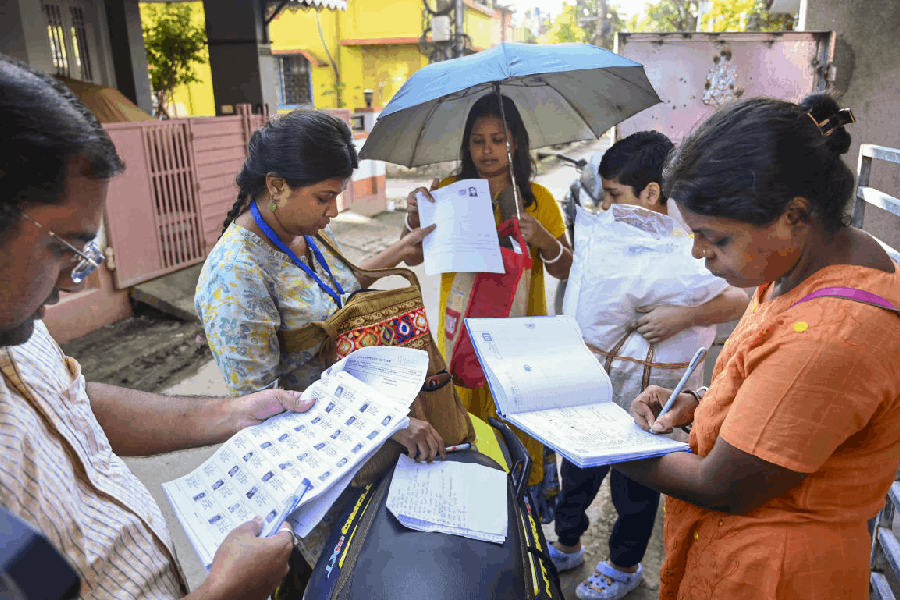 |
| Phool Kumari Devi and husband Satya Narayan Bhagat check the lady’s finger crop at Manjhauliya village in Muzaffarpur . Pictures by Nagendra Kumar Singh |
Muzaffarpur, May 5: Not every farmer in Bihar is pinning hopes on a good monsoon. There are some, albeit small and mostly women, farmers who are assured a high yield without depending much on water, chemical fertilisers or herbicides.
A new kind of seed treatment called systematic crop intensification (SCI) is at the root of a success story growing in Bihar’s small farmlands.
Sample this. Till a year ago, Satya Narayan Bhagat (63) and Phool Kumar Devi (61) of Manjhauliya village in Bochaha block, led a pathetic life. Their six cottahs of land did not produce enough crops to fill every belly in their eight-member household. Today, they not only produce enough crops to meet their needs but also to send their two children, Sohit Prasad (13) and Mohit Prasad (16), to school. All thanks to Jeevika initiative of the Bihar Rural Livelihoods Promotion Society, an independent organisation set up by the state and supported by the World Bank.
“Ever since we adopted SCI, our lives have changed altogether. We never imagined we would be able to send our children to school.” Devi said. About SCI, Devi said, “Of our 1.5-acre plot, six cottahs are under farming. We use 1 kg of clean seeds for two cottahs of land. The seed is soaked for 12 hours in 2l of warm water to which 200gm of jaggery, 300gm vermicompost and 300ml of cow urine have been added. The whole thing is then wrapped in cloth and left for 24 hours. After that, the seeds are transplanted at 8-inch intervals (and not crowded), leaving sufficient air for the roots. Under SCI, water use is low but production is high, harvest has gone up from 50-60 kg of rice per cottah to 100-120 kg per cottah.”
The couple saves around Rs 25,000 every season and gets good money by selling vegetables too. “We had mortgaged 3 cottahs of land. This year I repaid the loan and got it back. I have also started honey production. I do not have a tractor but I’m sure I’ll own one in five years,” Bhagat said. The couple also earns good money by selling vermicompost. “One kg of vermicompost costs Rs 5 and we make a profit of Rs 1,000-1,500 by selling this every month. In SCI, there is hardly any use of chemicals or fertilisers.” The couple grows wheat, paddy, maize, potatoes, ladyfinger and onions.
SCI is presently implemented in nine districts, namely Muzaffarpur, Madhubani, Supaul, Madhepura, Saharsa, Purnea, Nalanda, Gaya and Khagaria. By next year it would be rolled out in all 38 districts.
Ram Devi (35) and Chandra Kala Devi (60) in Shivraha Vasudev village are another success story. “During strong winds, I and my husband Stayandra Rai used to rush out to hold our homes (built of bamboo) from being blown away. Since adopting SCI, we’ve built a concrete house. We don’t fear strong winds anymore,” said Ram Devi. The financial security they enjoy comes from a Rs 22,000 profit reaped every season from 10 cottahs of land. “In the past eight months, I have bought a cow and opened two grocery stores, now being run by my sons. I am now an independent and financially strong woman,” says Ram Devi.
Chandra Kala Devi looks forward to adopting this new system wholly after it helped pay her son Amrendar Kumar’s BEd course fee. “My son wanted to study further, but we did not have the money. But, just two months into SCI, I have managed to pay the Rs 1.5 lakh fee. My son is studying at Maharshi Dayanand BEd College, Jaipur,” she said. She also sends him Rs 3,000-4,000 as monthly pocket money.
Around 30,000 villagers in this block, mostly women, are farming though SCI. Jeevika area coordinator of Bochaha block Pawan Kumar Singh, said, “The women in this village were earlier known by their husband’s names but today they have their own identity. The best part is that they have started speaking and interacting with everybody while earlier they would not even utter their husband’s name.
University professor-cum-chief scientist (Rice) and chairman, department of plant breeding and genetics, Rajendra Agriculture University, Pusa, Samastipur, N.K. Singh said, “Ten years down the line his system would be widely used by all farmers. However, farmers who have more land cannot adopt this system, because labour cost is very exhaustive. ”











